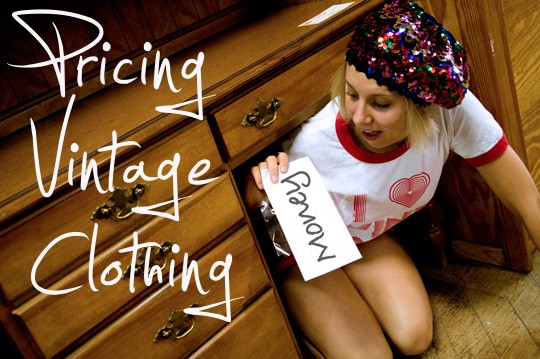
After posing the question, “How do you price vintage clothing?” on the Facebook page a few weeks ago, I was left wondering if it was worth asking the question at all.
Why? Because it seemed like everyone had their own point-of-view, and that there was no “industry standard” for accurately and fairly pricing vintage clothing.
Read a sampling of replies I pulled from the Facebook comment thread to see my point:
THE POINT-BY-POINT ANALYZER
“Desirability, condition, market trends and comparison to similar items. What we paid is irrelevant to what it will sell for, but if we have had something professionally restored that may factor into the retail price. The old adage is true, something is only worth what the customer will pay. But there are many different customers for vintage, a young trendy customer, an older classic conservative customer, the designer, the reseller, the museum, the TV or theater costume department, etc. Some dealers can sell an item another dealer cant simply because they have a different buyer. So I think the trick is knowing who your customers are and what their needs are. Then finding your pricing niche.” – Jennifer Karpin
THE TREND FORECASTER
“It’s about demand and I compare to items on eBay and auction sites. It’s also about condition, and market locale. In the Northeast there are hot vintage items that the Southerners would be like, ‘Huh? Why is that so hot?’ Also, what is trending – Steampunk? Okay, old poison bottles and watchfobs, hatpins, anything with old gears. You have to keep your hand on the pulse of what the current trends are in pop culture as well as what’s truly highly collectible.” – Mel Baerry
THE EVALUATOR
“I do tons of comparisons to other similar items. The problem is many people will price something high ‘just because’ it’s vintage and that can throw off the true value. Not all vintage is in demand and not all vintage is worth the high price. It depends what someone is willing to pay and I’ll often start with a higher price if I’m not sure. Then, I discount later if it doesn’t move.” – Veronica Cizmar, Some Like it Vintage
THE TRADITIONALIST
“I always start with how much I paid for it and add in cost for cleaning and repairs. Then factor in rarity, designer, condition. Also if I know a larger item such as a winter coat is going to take up valuable real estate during the summer, I may charge the item rent.” – Carla Rey, Carla & Carla Vintage
It was after Heather McWilliams of Good ‘N Plenty Vintage sent me a mock-up for her “pricing formula” that the truth clicked.
In my opinion, pricing vintage needs to be evaluated based on two points of considerations:
The cost of product and all other costs associated with it
x
A “mark-up” value based on subjective analysis of condition, trend, demand and desirability
The formula I developed weighs all factors of how to price vintage but is based on the traditional idea that vintage sellers should create a “mark-up” buffer value between cost of product and what their customer’s ultimately pay for it. This mark-up buffer is essentially your profit margins – which should be a seller’s end-all goal to have in order to make a living versus selling vintage as a labor of love.
What is your opinion? Does the formula below work for pricing vintage in a fair way for both seller and customer?
Let me know in the comments below, or by saying hello on Twitter, Facebook, Instagram or subscribing to my newsletter.
xx, SD
A Quick Video Intro from Me
The Formula
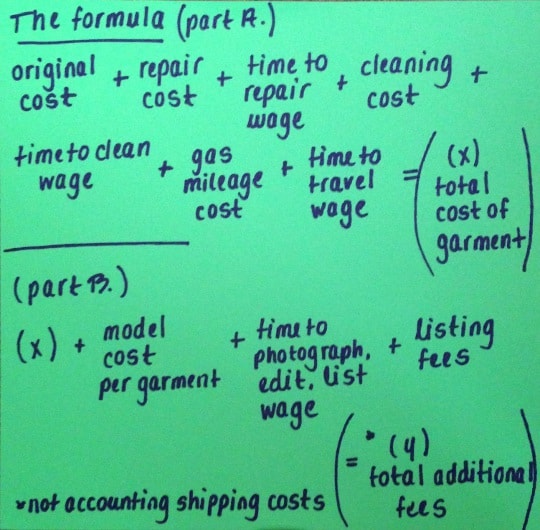
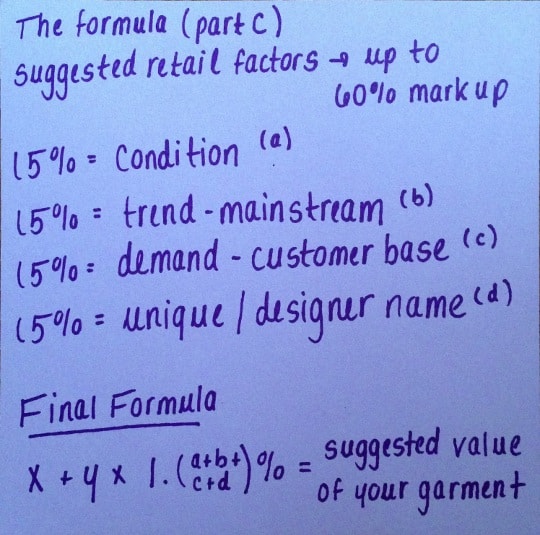
All Together
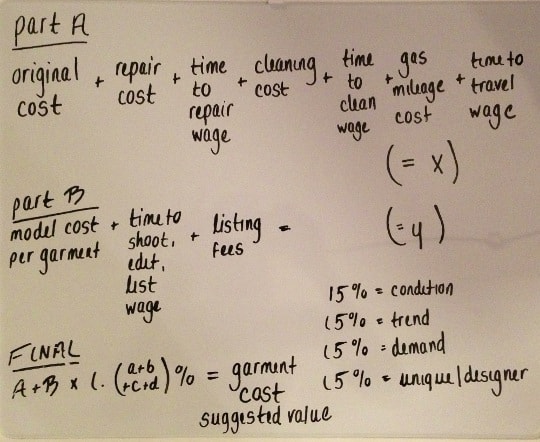
Additional resources
Notes for Reference
Your billable hour = $30
Your car is a Toyota Sequoia at 15 miles per gallon
You live in the state of New York where gas averages $3.72 a gallon
Example: Betsey Johnson Dress
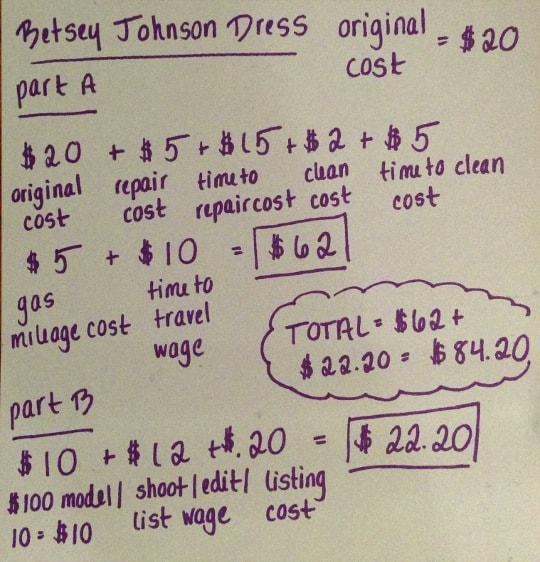
Steps to Take
Part A
(Original cost = $20) + (Repair cost = $5 (say for a new zipper) +
(Time to repair cost = $15 if your billable hour is “$30”) +
(Clean cost = $2 (say, for the laundry mat) + (Clean cost time = $5 (if it takes you 10 minutes to switch laundry) +
(Mileage cost = $5 ($3.72 per gallon/15 miles per gallon for Toyota =.25 x 20 miles travel to buy garment) +
(Travel time wage = $10 (going 60 MPH, traveling 20 miles = 20 minutes travel time) = TOTAL for Part A
Total = $62
Part B
($10 = ($100 for model/ 10 outfits) + ($12 = (4 hours shoot/edit/list time, 10 outfits/4 = 2.5 outfits per hour, $30/2.5 = $12) + (.20 (Etsy listing fee) = $22.20 = TOTAL for Part B
$64 + $22.20 = $84.20
The Suggested Retail Price
In all economies of goods, there is a “mark up” price that creates a profit margin for the seller.
This is what part C entails. You can determine how much you want to mark up your good – from nothing (although I don’t recommend it!) to how high as you want your ceiling to be.
The suggested mark up value – taking into account you may need to put the item on sale at some point, and you still want to make a profit – is anywhere from 40 to 60%.
For this example, let’s say you want use the margins of 60%.
In the vintage industry, there are four key factors to consider when determining this subjective markup value: The garment’s condition, trend value, demand within your customer base and unique qualities/designer name panache.
Consider each 15% like 100% for the garment’s value in that vertical. If the garment is perfect, give it 15%. If it could be better, try 12%. If there’s some major issues, go below 10%. The percentages are up to you.
Let’s say Betsey is perfect and she gets perfect scores all around.
We take her “wholesale” price of $84.20 and multiply it by 1.6.
$84.20 x 1.6 = $134.72 suggested average retail price.
What Else to Consider When Pricing Vintage
Maybe like eating a Reese’s, there’s no “wrong” way to price vintage. If you’d rather not use my formula for pricing vintage, here are some of the most important points to consider when developing your own system.
1.) The Trends
This season online sellers are telling me “they can’t neons in their shops” for longer than a few days.
Whether you read up on the trends or just keep your ear to the ground when meeting with teenagers and fashion-forward females, it’s important that you find a trend muse to help you keep on top of what the mainstream audience wants. This ensures that you won’t pass up buying a trend and marking it to appropriate supply-and-demand value.
2.) Comparison to Other Shops
Perhaps one of the smarter business strategies for any seller of any goods is to research the competition. If a shop is selling Betsey Johnson dresses for an average of $100, perhaps your $50-$75 Betsey styles should list similarly.
But keep in mind that different shops attract different customers based on how they present their garments and market their branding. If you don’t have girls ready to hand over a Benjamin for a Betsey, then chances are that at least to begin with, you’re better off creeping prices up slightly rather than full force.
3.) How Much Do You Like It
When I managed a vintage boutique in New York City’s Lower East Side, we’d have a running joke that “if we liked it, it got $10 extra dollars” added to price amount.
As sellers, our garments are like our children, and yes we want to value our children as much as possible! So understandably, if you have a thing for polka dots and just feel it deserves a couple extra dollars for the pattern alone, you may just find yourself marking up your favorite vintage “children” of the shop.
4.) A “6th Sense” Hunch
Sometimes you just know that an item is going to fly off the digital selves. Whether it’s because you’re an established seller and you know the style preferences of your customer base, or perhaps the color of a piece is so captivating your inner gut tells you it’ll get scooped up on attractiveness alone – this is the hunch you trust when adding a few extra dollars to that special garment.
5.) Seasonal Influences
Cut-off shorts won’t sell in December just as much as fur collared ’50s swing coats won’t sell in July. Keeping off-season garments in your shop should lower the price, since the product shouldn’t be in demand for the bulk of your customers. However, international customers may profit (such as Australians, New Zealanders) from buying your off-season garments at a discount during their on-season for wearing them.
What are your thoughts on today’s post? Leave your questions, comments and contributions in the comments below.
Need help marketing your online or brick & mortar vintage store? Schedule a consulting call with me today!
![]()
****
Want to sell vintage clothing online? Learn from the pros.

Get an excerpt of my e-book, The 100 Best Vintage Shops Online, for FREE here!
A Funny Blooper
Because you should never take yourself so seriously. Watch till the end ;-)

Love the how much do you like it & 6th sense price adjustments!!! We all have those… Some things are hard to let go of :)
Ha, yes had to include the “Sixth Sense” because we all know it can be a gut feeling. Did you get a chance to test the formula?
this formula rocks. a great benchmark for vintage resellers. thanks!
Can’t wait for more feedback – get this formula locked and loaded!
Your formula is a great start Sammy. I do from experience feel that your mark up factor on condition is low. On just about anything vintage, including clothing, condition is everything and is in a category all its’ own. Otherwise, you have pretty well hit it on the head.
PS, love the new hair cut! NMB
Rachel D. the person who mentioned an interview request is a scammer. She stole images from my website and sold the items on eBay BEFORE she purchased them from my store. She used my images and descriptions in her listings. She’s right when she says she does minimal labor because she doesn’t do anything but right click and save!!! I have 21 eBay listings to prove everything she did. Not someone I would want to be associated with.
THANK YOU!!! It’s like having new glasses!!! I can see everything so clearly with this formula. I’m going through my inventory now!
Two things I especially love:
1. It forces me to acknowledge and place a value on my time and hard work, and we all know there is a lot of time and hard work involved in selling vintage!
2. It allows me to see straight away what items are viable and what aren’t. Just by knowing that I will need to ad $x for my travel and time and $x to photo/list/clean before I can even think about making a profit makes me realise certain smaller items I was carrying thinking they had a great mark up (knitting patterns & scarves for example) actually don’t bring in enough – if sold individually – to cover the cost of listing them.
Shop day tomorrow, I’ll be one busy squirrel
Thanks
Colleen
The effect that went to the article is beyond impressive and had to be noted primarily. However I think people overcomplicated the whole thing. I check ebay sold listings which helps as a baseline, but I think every vintage shop and seller who is even semi consistently is making sales for like 6 months + starts to understand that it’s beyond basic quick eBay sold listings and/ or maybe reaching out for the opinions of other fellow vintage seller buddies that it’s best to trust your instincts and just price it ( When completely in doubt maybe I am high you can always lower it) But this is a situation where there really is no right answer the answer of what the value is whatever one person is willing to pay for it. All you need is one person, And yeah there are times when I’ve face palm that I’ve been like damn I weigh under price that (Absolutely would not advise canceling a sale like that you need to follow through just from a trust and ethical standpoint with buyers that stuff gets around and sellers do that) yeah but in the end you ship the item and you move on and you can’t like give yourself a stroke trying to price it correctly or beat yourself up if you underpriced it it’s not worth it.. and again I want to reiterate that there is no exact science to it there’s literally no anything I think you understand that and it was good he provided all the information but it’s really important people understand the items literally worth whatever somebody one person will pay for it.
I can’t see where government tax due on the profit is factored in?